To Johannesburg with an open mind
A short
summary
 Nikki and I went on a trip to Johannesburg in South Africa from December
13th to December 31st 2004. The main goal for our trip was of course to see
Nikki’s family and friends but we also got a chance to visit places like the
Apartheid museum, Constitution Hill, the theme park Gold Reef City, Cradle
of Humankind, South African National Museum of Military History etc. We also
got to go on a wonderful safari at Djuma Game Reserve located in the Sabi
Sand Game Reserve near the Kruger Park (click
here for a seperate trip report
for this). Although this was a family trip I
hope that some of the information in this trip report can be of some use to
others. Get in touch if you have any questions or comments and I’ll do my
best to answer.
Nikki and I went on a trip to Johannesburg in South Africa from December
13th to December 31st 2004. The main goal for our trip was of course to see
Nikki’s family and friends but we also got a chance to visit places like the
Apartheid museum, Constitution Hill, the theme park Gold Reef City, Cradle
of Humankind, South African National Museum of Military History etc. We also
got to go on a wonderful safari at Djuma Game Reserve located in the Sabi
Sand Game Reserve near the Kruger Park (click
here for a seperate trip report
for this). Although this was a family trip I
hope that some of the information in this trip report can be of some use to
others. Get in touch if you have any questions or comments and I’ll do my
best to answer.
Prelude
 I have been to Johannesburg
(Joburg) before and in the past I have been a bit negative about the
place. Why? Well, it is not easy to come from a small town in Norway to the
big city. It is a bit frightening to come to a big city where the general
advice is to keep your car door locked when you are driving, where most
homes have bars in front of doors and windows and electrical wires on top of
the big fences that surround the properties etc. I have always felt a bit
more…eh…free in Cape Town.
But I promised Nikki that I would go to Joburg with an open mind and take
another look at the city :-)
I have been to Johannesburg
(Joburg) before and in the past I have been a bit negative about the
place. Why? Well, it is not easy to come from a small town in Norway to the
big city. It is a bit frightening to come to a big city where the general
advice is to keep your car door locked when you are driving, where most
homes have bars in front of doors and windows and electrical wires on top of
the big fences that surround the properties etc. I have always felt a bit
more…eh…free in Cape Town.
But I promised Nikki that I would go to Joburg with an open mind and take
another look at the city :-)
| Did you know: South Africa has 11 official languages |
A few words about South Africa
 |
| Map provided by: www.worldatlas.com |
I guess most people know where South Africa is located…after all it is in the name :-) The Republic of South Africa has a population of about 45 million and about 3 million of them live in Joburg. Before I got to know South Africa through Nikki I guess I only knew the basics which can be summarized in keywords such as apartheid, Nelson Mandela, gold and diamonds.
 The
new flag was introduced after the free elections in 1994. The red, white and
blue colours were taken from the colours of the Boer Republics while the
yellow, black and green are taken from the African National Congress (ANC)
flag where the black symbolizes the people, green the fertility of the land,
and the yellow the mineral wealth in the form of gold.
The
new flag was introduced after the free elections in 1994. The red, white and
blue colours were taken from the colours of the Boer Republics while the
yellow, black and green are taken from the African National Congress (ANC)
flag where the black symbolizes the people, green the fertility of the land,
and the yellow the mineral wealth in the form of gold.
Practical
information
In South Africa it is common with three pronged plugs and it is 220 volts. I
bought an adapter at the airport in Frankfurt and that was a real rip of. My
advice is of course that you wait until you get to South Africa to buy
it...it is much cheaper.
The currency in South Africa is Rand and most of the prices in this trip report with be listed in this currency. There is a lot more practical information on the Internet. Here is one page I found.
| Did you know: Joburg is located at about 1740 meters (5700 feet) above sea level? |
The trip
begins
 Getting tickets to South Africa was not as easy as we had expected. Over the
past couple of years it has become increasingly popular to go to South
Africa and I guess this trend will continue as we get closer to the soccer
World Cup in 2010. We ended up flying
South African Airways (SAA)
and we had to pay about 9200 Norwegian kroner (about 1500 US dollars) per
person for the tickets. On Monday December 13th we took the short 1 ½ hour
flight from Stavanger to Frankfurt with Lufthansa and after a few hours we
boarded the SAA plane. I was not very impressed by the
Frankfurt Airport. It’s supposed to be one of the busiest airports in
Europe but I think Schiphol in Amsterdam is far better. It was hard to
navigate around the airport in Frankfurt due to both strange maps and lots
of passport control points. And there were not that many shops to browse
around in.
Getting tickets to South Africa was not as easy as we had expected. Over the
past couple of years it has become increasingly popular to go to South
Africa and I guess this trend will continue as we get closer to the soccer
World Cup in 2010. We ended up flying
South African Airways (SAA)
and we had to pay about 9200 Norwegian kroner (about 1500 US dollars) per
person for the tickets. On Monday December 13th we took the short 1 ½ hour
flight from Stavanger to Frankfurt with Lufthansa and after a few hours we
boarded the SAA plane. I was not very impressed by the
Frankfurt Airport. It’s supposed to be one of the busiest airports in
Europe but I think Schiphol in Amsterdam is far better. It was hard to
navigate around the airport in Frankfurt due to both strange maps and lots
of passport control points. And there were not that many shops to browse
around in.
We got on board the SAA flight at about 9 and it was a fairly new Airbus plane (A340-600 maybe). I was of course looking forward to trying the in flight entertainment that I never got to try when I was fly Continental to the USA this summer. But it turned out that I would be disappointed once again. Our little TV screen did not work at all during our 10 hour flight to Joburg…and I have trouble sleeping on board planes so it was a boring flight. But I was quite impressed with SAA in general. They seemed to listen to us when we were unhappy when the TV wasn’t working, the food was pretty good and the service was good.
We arrived the following morning in Joburg and we were met by lovely weather and about 27 degrees Celsius. The arrivals part of the airport has not changed much since I went to South Africa for the first time in 1997. Nikki’s family came to pick us up at the airport so we didn’t have to worry about getting a taxi. Coming to Joburg is not a big culture shock...at least not to start with. When I came to Joburg the first time I just reminded me of a typical big city with high rise buildings and big freeways.
Stuff to see
and do
So what is there to see and do in Joburg? I get the impression that most
people just stay overnight in Joburg because they “have to” in connection
with a safari in the Kruger Park. And when I went to Joburg the first times
I also got an impression from guide books that there was not much to see and
do. But this time we wanted to spend some time "discovering" Joburg. Nikki’s
father did a great job playing the tour guide for us :-)
Constitution
Hill
 If
there is one thing I would recommend as a “must see” it would be
Constitution Hill. This is the home of the Constitutional Court in South
Africa and it is built on the site of and old prison. The prison was called
Old Fort Prison Complex but was commonly known as Number Four. Many leading
political activists including Mahatma Gandhi and Nelson Mandela were kept
here for periods. The prison itself did not close until 1983 and the main
reason was that it was getting overcrowded.
If
there is one thing I would recommend as a “must see” it would be
Constitution Hill. This is the home of the Constitutional Court in South
Africa and it is built on the site of and old prison. The prison was called
Old Fort Prison Complex but was commonly known as Number Four. Many leading
political activists including Mahatma Gandhi and Nelson Mandela were kept
here for periods. The prison itself did not close until 1983 and the main
reason was that it was getting overcrowded.
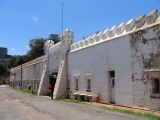 When
we got there we thought the place was closed because there was only one car
in the parking lot and it was a public holiday. We got a great tour of the
area with a guy called David. He took us through the history of the prison
with his great knowledge and he could tell us a lot about the past but also
about the complex today. We started looking at the old fort entrance and the
barrier that is built around the fort and we were told how the prisoners
were treated when they first arrived. We were taken through the old cells
where we could look at sleeping arrangements, isolation cells and there were
also small rooms with TV’s where we could here stories told by people that
were kept in the prison. The tour ended in the Constitutional court itself.
When
we got there we thought the place was closed because there was only one car
in the parking lot and it was a public holiday. We got a great tour of the
area with a guy called David. He took us through the history of the prison
with his great knowledge and he could tell us a lot about the past but also
about the complex today. We started looking at the old fort entrance and the
barrier that is built around the fort and we were told how the prisoners
were treated when they first arrived. We were taken through the old cells
where we could look at sleeping arrangements, isolation cells and there were
also small rooms with TV’s where we could here stories told by people that
were kept in the prison. The tour ended in the Constitutional court itself.
 But
the main thing in this complex is the symbolism. Part of the prison (known
as the Awaiting Trial Block) was torn down to make room for the court
itself.
But
the main thing in this complex is the symbolism. Part of the prison (known
as the Awaiting Trial Block) was torn down to make room for the court
itself. In order to show that the injustice of the past can be a part of the justice
for the future, the bricks have been re-used in the new court house. The
stairwells to the building have been preserved and two are even incorporated
in the court building itself. The Constitutional Court is also a building
full of symbolism. The logo itself shows people in shelter under a tree
discussing and it represent the past way of doing things. This can also be
seen in the lobby of the court house where pillars are skew to represent the
tree trunks and natural light comes in through the ceiling and the lights
are formed like leaves. The door into the court itself is a 9 meter timber
door and 27 human rights are carved into the wood.
In order to show that the injustice of the past can be a part of the justice
for the future, the bricks have been re-used in the new court house. The
stairwells to the building have been preserved and two are even incorporated
in the court building itself. The Constitutional Court is also a building
full of symbolism. The logo itself shows people in shelter under a tree
discussing and it represent the past way of doing things. This can also be
seen in the lobby of the court house where pillars are skew to represent the
tree trunks and natural light comes in through the ceiling and the lights
are formed like leaves. The door into the court itself is a 9 meter timber
door and 27 human rights are carved into the wood.
 It
might sound boring to see a prison and a court house but I learned a lot
from it. The fact that this place of terror only shut down about 20 years
ago makes it frightening. I think that it was amazing to see how they have
used symbolism to bring the past with them in order to prevent that stuff
like this happens again. Please visit the website
www.constitutionhill.co.za to get more info on how to get there etc. If
you go there make sure to get a guide!
It
might sound boring to see a prison and a court house but I learned a lot
from it. The fact that this place of terror only shut down about 20 years
ago makes it frightening. I think that it was amazing to see how they have
used symbolism to bring the past with them in order to prevent that stuff
like this happens again. Please visit the website
www.constitutionhill.co.za to get more info on how to get there etc. If
you go there make sure to get a guide!
| Did you know: In 1905 the largest gem-quality diamond ever discovered was found in South Africa. This stone still remains the largest diamond ever found. The Cullinan I, known as The Great Star of Africa, is the largest cut diamond in the world; it is a 530.20 carat pear shaped stone set in the Sovereign's Royal Scepter as part of the Crown Jewels displayed in the Tower of London. |
Gold Reef
City
 If
you get tired of museums and shopping you can take a trip to Gold Reef
City and have some fun :-). The place is a theme park built on the
concept on mining.
If
you get tired of museums and shopping you can take a trip to Gold Reef
City and have some fun :-). The place is a theme park built on the
concept on mining.
 Not
only is South Africa known for its gold and diamond mines…Johannesburg
itself is located right on top of one gold ore and the park itself is built
around and on top of No. 14 shaft of Crown Mines. But most people come here
just for the ride and fun of course. We went with my brother and sister
in-law, Karabo and Ame. After paying 80 Rand per person (only toddler’s
don’t pay) at the entrance we got access to the park and all the rides in
the park. In the park we had great fun trying out the roller coasters
Anaconda, Jozi Express, Golden Loop and Tower of Terror. The last one is not
really a roller coaster but you get a 47 meter drop which is pretty mean :-)
We had to wait for quite some time for this because they only had one car
and only 8 people could go each time :-( Miner's Revenge was also quite fun
and to our surprise we also got a bit soaked on it.
Not
only is South Africa known for its gold and diamond mines…Johannesburg
itself is located right on top of one gold ore and the park itself is built
around and on top of No. 14 shaft of Crown Mines. But most people come here
just for the ride and fun of course. We went with my brother and sister
in-law, Karabo and Ame. After paying 80 Rand per person (only toddler’s
don’t pay) at the entrance we got access to the park and all the rides in
the park. In the park we had great fun trying out the roller coasters
Anaconda, Jozi Express, Golden Loop and Tower of Terror. The last one is not
really a roller coaster but you get a 47 meter drop which is pretty mean :-)
We had to wait for quite some time for this because they only had one car
and only 8 people could go each time :-( Miner's Revenge was also quite fun
and to our surprise we also got a bit soaked on it.
 But
the highlight for me in the park was the underground tour. We had to pay an
extra 50 Rand per person for this but hey, it is not every day you get to go
down in a real gold mine :-) This is no. 14 shaft of Crown Mines but it was
actually the 13th shaft according to our guide but they skipped this number
due to superstition. After getting a helmet and torch (with a big battery
pack) we were lowered down to 220 meters below ground level and we got a
short and hectic tour of the first level of this mine that stretched down to
a staggering 3293 meters (about 10000 ft). The mine itself was shut down in
1977 and at the time they only produced 4 grams of gold per ton of rock that
was mined.
But
the highlight for me in the park was the underground tour. We had to pay an
extra 50 Rand per person for this but hey, it is not every day you get to go
down in a real gold mine :-) This is no. 14 shaft of Crown Mines but it was
actually the 13th shaft according to our guide but they skipped this number
due to superstition. After getting a helmet and torch (with a big battery
pack) we were lowered down to 220 meters below ground level and we got a
short and hectic tour of the first level of this mine that stretched down to
a staggering 3293 meters (about 10000 ft). The mine itself was shut down in
1977 and at the time they only produced 4 grams of gold per ton of rock that
was mined.
 It
is amazing to be able to get to go down in a real mine and get an impression
of what the working conditions were like. There is a pretty good description
of the underground tour on
this page. We also went to see the
gold pouring but due to bad luck the show had to be cancelled due to
electrical problems. According to what I have read you get to see 12.5 kg of
gold being poured and made into a gold bar. And they say you can take it
home if you can pick it up with one hand on the first try…well, I was
looking forward to bringing that gold home! :-) Check out their website on
www.goldreefcity.co.za for more information and directions. The park is
worth a visit and you can have fun and learn a bit about the Joburg and
mining history at the same time :-)
It
is amazing to be able to get to go down in a real mine and get an impression
of what the working conditions were like. There is a pretty good description
of the underground tour on
this page. We also went to see the
gold pouring but due to bad luck the show had to be cancelled due to
electrical problems. According to what I have read you get to see 12.5 kg of
gold being poured and made into a gold bar. And they say you can take it
home if you can pick it up with one hand on the first try…well, I was
looking forward to bringing that gold home! :-) Check out their website on
www.goldreefcity.co.za for more information and directions. The park is
worth a visit and you can have fun and learn a bit about the Joburg and
mining history at the same time :-)
Apartheid
museum
 When
growing up I remember seeing news stories on TV about a South Africa ruled
by the apartheid government. In 1990 Nelson Mandela was finally released
from Robben Island after 27 years in prison, he won the
Nobel Peace Prize
together with Frederik Willem de Klerk in 1993 and won the first free
elections in 1994. The Apartheid museum is located right next to Gold
Reef City. The entrance is pretty clever…it is split in two entrances: one
for the ‘whites’ and one for the ‘non-whites’. To start with you get a bit
of information about the race classification in the old regime. From there
on we went through the museum to look at life (for both sides) under the old
regime, about the homelands, about the Soweto uprising etc.
When
growing up I remember seeing news stories on TV about a South Africa ruled
by the apartheid government. In 1990 Nelson Mandela was finally released
from Robben Island after 27 years in prison, he won the
Nobel Peace Prize
together with Frederik Willem de Klerk in 1993 and won the first free
elections in 1994. The Apartheid museum is located right next to Gold
Reef City. The entrance is pretty clever…it is split in two entrances: one
for the ‘whites’ and one for the ‘non-whites’. To start with you get a bit
of information about the race classification in the old regime. From there
on we went through the museum to look at life (for both sides) under the old
regime, about the homelands, about the Soweto uprising etc.
 The
museum didn’t look that big when we arrived but you need some time to go
through the museum. We got there a bit late and before we knew it, it was 5
pm and we got “kicked out” of the place.
The
museum didn’t look that big when we arrived but you need some time to go
through the museum. We got there a bit late and before we knew it, it was 5
pm and we got “kicked out” of the place.
 You
probably need 2-3 hours to go through the museum. I think we paid 25 Rand
per person to get into the museum. Some of the videos in the museum showed
the Soweto uprising and how the police went about to control the situation.
I guess when you see how brutal the police were in some situations it is
easy to understand that the police still have a bit of a bad reputation in
South Africa. And I guess it also shows that it will take some time for the
wounds to heal and for the country to move on. The museum web page on
www.apartheidmuseum.org
contains more information on the exhibitions, the history, other places of
interest etc.
You
probably need 2-3 hours to go through the museum. I think we paid 25 Rand
per person to get into the museum. Some of the videos in the museum showed
the Soweto uprising and how the police went about to control the situation.
I guess when you see how brutal the police were in some situations it is
easy to understand that the police still have a bit of a bad reputation in
South Africa. And I guess it also shows that it will take some time for the
wounds to heal and for the country to move on. The museum web page on
www.apartheidmuseum.org
contains more information on the exhibitions, the history, other places of
interest etc.
Soweto
 It
is said that a visit to Joburg is not complete until you have visited
Soweto. There are
lots of companies that offer tours in the township but we didn’t have to
organize this since we had local guides :-) Soweto is located south west of
Joburg and the name itself stands for “SOuth WEstern TOwnship”.
It is a HUGE area today and the estimate of how many people that live there
vary from 1.5 million to 3 million people.
It
is said that a visit to Joburg is not complete until you have visited
Soweto. There are
lots of companies that offer tours in the township but we didn’t have to
organize this since we had local guides :-) Soweto is located south west of
Joburg and the name itself stands for “SOuth WEstern TOwnship”.
It is a HUGE area today and the estimate of how many people that live there
vary from 1.5 million to 3 million people.
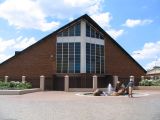 Driving
into Soweto was like coming to a totally different place at least if you
compare it with the rest of Joburg. First of all the houses are much smaller
and there is not much vegetation in the form of trees. There were people
everywhere and the rumour has it that the unemployment rate is quite high. I
guess that also explains all the people that were trying to set up
businesses like car wash, car repair shop etc around in Soweto. We started
out by visiting the large Catholic Church called Regina Mundi. This
church has played a key role in the history of Soweto and the uprising
against the apartheid government. There is not that much to see in the
church today but there is a nice article about the history on
this page.
Driving
into Soweto was like coming to a totally different place at least if you
compare it with the rest of Joburg. First of all the houses are much smaller
and there is not much vegetation in the form of trees. There were people
everywhere and the rumour has it that the unemployment rate is quite high. I
guess that also explains all the people that were trying to set up
businesses like car wash, car repair shop etc around in Soweto. We started
out by visiting the large Catholic Church called Regina Mundi. This
church has played a key role in the history of Soweto and the uprising
against the apartheid government. There is not that much to see in the
church today but there is a nice article about the history on
this page.
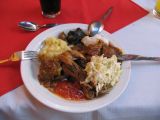 We
needed something to eat so we stopped by one of the most popular places for
tourist in Soweto: Wandies Place. The restaurant was packed when we
came there but they managed to squeeze us in but the service was pretty slow
because there were so many guests. They mainly serve a buffet and I think
that it cost us 50 Rand per person for the meal (excluding dessert). On the
buffet there were different dishes of chicken, lamb, beef and curry
varieties. There were also some “typical” South African dishes on the menu
such as pap which is like the rice part of a meal and it is some sort of
cornmeal porridge. When I came into the buffet I was met by an unusual smell
– at first I though something had gone off. But it turned out to be
something called ‘mala mogodu’ or tripe – boiled and seared sheep intestines
and/or stomach. My sensitive nose felt a bit assaulted but the tripe didn’t
taste all that bad – not one of the worst sheep parts one can eat :-)
We
needed something to eat so we stopped by one of the most popular places for
tourist in Soweto: Wandies Place. The restaurant was packed when we
came there but they managed to squeeze us in but the service was pretty slow
because there were so many guests. They mainly serve a buffet and I think
that it cost us 50 Rand per person for the meal (excluding dessert). On the
buffet there were different dishes of chicken, lamb, beef and curry
varieties. There were also some “typical” South African dishes on the menu
such as pap which is like the rice part of a meal and it is some sort of
cornmeal porridge. When I came into the buffet I was met by an unusual smell
– at first I though something had gone off. But it turned out to be
something called ‘mala mogodu’ or tripe – boiled and seared sheep intestines
and/or stomach. My sensitive nose felt a bit assaulted but the tripe didn’t
taste all that bad – not one of the worst sheep parts one can eat :-)
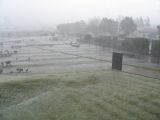 We
continued our tour in Soweto by stopping by the corner where Hector
Pieterson was shot dead by the police on June 16th 1976. He took part in a
demonstration against the introduction of Afrikaans as a language in the
black schools. Hector was only 12 years old. We also stopped by Hector
Pieterson museum and it only cost 10 Rand to enter. In the museum you
will find information about the events leading to June 16th and the uprising
that followed. You will find quite a lot of information on
this page. The museum was not that
big and I found the Apartheid Museum more interesting. When we drove into
Soweto the weather was great but at the museum we were surprised by an
earsplitting hail storm. Fortunately, it wasn’t the big windscreen cracking
type.
We
continued our tour in Soweto by stopping by the corner where Hector
Pieterson was shot dead by the police on June 16th 1976. He took part in a
demonstration against the introduction of Afrikaans as a language in the
black schools. Hector was only 12 years old. We also stopped by Hector
Pieterson museum and it only cost 10 Rand to enter. In the museum you
will find information about the events leading to June 16th and the uprising
that followed. You will find quite a lot of information on
this page. The museum was not that
big and I found the Apartheid Museum more interesting. When we drove into
Soweto the weather was great but at the museum we were surprised by an
earsplitting hail storm. Fortunately, it wasn’t the big windscreen cracking
type.
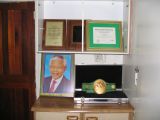 We
also stopped by Nelson Mandela’s first house in Orlando West in
Soweto. The humble house was Mandela’s home from 1946 and it is a tiny
place. I think that we had to pay 20 Rand per person to get in and we got a
short 2 minute tour of the place. Yes, it is an intimate meeting with the
home of a great leader but there is not much to see. And if you compare the
entrance fee to other attractions that we went to I’m almost tempted to call
it a overcharge. I would say that it is not worth a visit. There is a bit of
information about his old house on
this page.
We
also stopped by Nelson Mandela’s first house in Orlando West in
Soweto. The humble house was Mandela’s home from 1946 and it is a tiny
place. I think that we had to pay 20 Rand per person to get in and we got a
short 2 minute tour of the place. Yes, it is an intimate meeting with the
home of a great leader but there is not much to see. And if you compare the
entrance fee to other attractions that we went to I’m almost tempted to call
it a overcharge. I would say that it is not worth a visit. There is a bit of
information about his old house on
this page.
 What
surprised me about Soweto was the fact that there were all sorts of houses
there. They ranged from typical suburban houses to squatter camp shanties
and everything in between. Looking out over the large area that the squatter
camp covered has a tendency to put things into perspective. I hope that many
of my fellow Norwegians get to travel the world so that we can realize how
fortunate we are. I regret not that I didn’t take more pictures in Soweto
itself. It would have been great to have some shots of the every day life in
this township.
What
surprised me about Soweto was the fact that there were all sorts of houses
there. They ranged from typical suburban houses to squatter camp shanties
and everything in between. Looking out over the large area that the squatter
camp covered has a tendency to put things into perspective. I hope that many
of my fellow Norwegians get to travel the world so that we can realize how
fortunate we are. I regret not that I didn’t take more pictures in Soweto
itself. It would have been great to have some shots of the every day life in
this township.
| Did you know: The only street in the world to house two Nobel Peace Prize winners is in Soweto. Nelson Mandela and Archbishop Desmond Tutu both have houses in Vilakazi Street, Orlando West. |
Cradle of
humankind and Rhino & Lion Nature reserve
 About
40-50 km outside Joburg you’ll find the Sterkfontein Caves which is a
part
of the Cradle
of humankind. We drove out there one day to get a tour of this place
where they have found fossils of our human ancestors so to speak. The first
cranium was found in 1936 and right now they are working on “digging out” a
skeleton that is believed to be about 4 million years old and 99.9 %
complete. But it is a slow process because they have been excavating this
one fossil since about 1994.
About
40-50 km outside Joburg you’ll find the Sterkfontein Caves which is a
part
of the Cradle
of humankind. We drove out there one day to get a tour of this place
where they have found fossils of our human ancestors so to speak. The first
cranium was found in 1936 and right now they are working on “digging out” a
skeleton that is believed to be about 4 million years old and 99.9 %
complete. But it is a slow process because they have been excavating this
one fossil since about 1994.
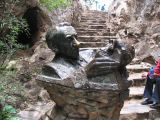 So
maybe we’ll get to see this Australopithecus Africanus (our guide seemed to
enjoy saying these words) in a museum in a few years time. We paid about 20
Rand per person for the tour of the cave and it seemed like the guide was
pretty knowledgeable when he took us through the cave. There are a few steps
down (and eventually up :-) and in some places you have to crawl a little
bit. There is a tiny museum at the entrance area that will tell you a little
bit about the history of the cave, the fossils that has been found there
etc. Due to the fossils found here the site has become a World Heritage
Site.
So
maybe we’ll get to see this Australopithecus Africanus (our guide seemed to
enjoy saying these words) in a museum in a few years time. We paid about 20
Rand per person for the tour of the cave and it seemed like the guide was
pretty knowledgeable when he took us through the cave. There are a few steps
down (and eventually up :-) and in some places you have to crawl a little
bit. There is a tiny museum at the entrance area that will tell you a little
bit about the history of the cave, the fossils that has been found there
etc. Due to the fossils found here the site has become a World Heritage
Site.
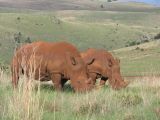 From
Sterkfontein we drove to Rhino & Lion Nature reserve. At the entrance we
paid to get into the Rhino and Lion reserve and to get a tour of a place
called Wondercave.
This cave belongs to the same system of caves as the Sterkfontein cave but
was quite different.
From
Sterkfontein we drove to Rhino & Lion Nature reserve. At the entrance we
paid to get into the Rhino and Lion reserve and to get a tour of a place
called Wondercave.
This cave belongs to the same system of caves as the Sterkfontein cave but
was quite different.
 Before
the tour we relaxed at the little café on the site and we were kept company
by an ostrich and a couple of wild boars :-) The tour started by descending
quite a few steep steps (45 degree steep) and then we took an elevator down
to about 60 meters below the surface. In the enormous cave there were
beautiful examples of both stalagmites and stalactites. Some of them were
humongous and weighed up to 40 tons according to our guide. The cave was
pretty dark and it was hard to take good pictures. It was kept dark to keep
the environment as natural as possible.
Before
the tour we relaxed at the little café on the site and we were kept company
by an ostrich and a couple of wild boars :-) The tour started by descending
quite a few steep steps (45 degree steep) and then we took an elevator down
to about 60 meters below the surface. In the enormous cave there were
beautiful examples of both stalagmites and stalactites. Some of them were
humongous and weighed up to 40 tons according to our guide. The cave was
pretty dark and it was hard to take good pictures. It was kept dark to keep
the environment as natural as possible.
 After
the visit to the cave we drove around in our car in the nature reserve. The
dirt roads were bumpy and most cars were in for a challenge. But we did
manage to get pretty close to lions,
After
the visit to the cave we drove around in our car in the nature reserve. The
dirt roads were bumpy and most cars were in for a challenge. But we did
manage to get pretty close to lions,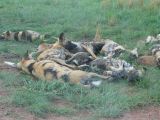 wild dogs, a cheetah, a couple of rhinos etc. It is pretty amazing to get
this close to the animals in your own car. I wonder if there are any
"accidents" in parks like this. After all there are a few daring tourists
out there and there were no supervision :-) There is also one area in the
park where you can find tigers, lions, crocodiles and hippos in more
confined areas. They also have a place where you can take a closer look at
vultures. You will find more information on their homepage
www.rhinolion.co.za
wild dogs, a cheetah, a couple of rhinos etc. It is pretty amazing to get
this close to the animals in your own car. I wonder if there are any
"accidents" in parks like this. After all there are a few daring tourists
out there and there were no supervision :-) There is also one area in the
park where you can find tigers, lions, crocodiles and hippos in more
confined areas. They also have a place where you can take a closer look at
vultures. You will find more information on their homepage
www.rhinolion.co.za
South
African National Museum of Military History
 When
Nikki’s dad came up with the suggestion to go to the
National museum
of Military history I said “sure” because I do have an interest in
history and like most boys I’m impressed by all sorts of gadgets :-) .
When
Nikki’s dad came up with the suggestion to go to the
National museum
of Military history I said “sure” because I do have an interest in
history and like most boys I’m impressed by all sorts of gadgets :-) .
 I
had never read or heard about this museum so I didn’t really have any
expectations at all before we got there. The museum is located is located
right next to the
Johannesburg Zoo and we paid 10 Rand to get in. I realized pretty
quickly that there were a lot to see and read in this museum. First of all
there is a lot of information about the military history (obviously *grin*)
and the aspects of the Anglo Boer war (between 1899 and 1902) are covered
with pictures, strategic plans, posters etc.
I
had never read or heard about this museum so I didn’t really have any
expectations at all before we got there. The museum is located is located
right next to the
Johannesburg Zoo and we paid 10 Rand to get in. I realized pretty
quickly that there were a lot to see and read in this museum. First of all
there is a lot of information about the military history (obviously *grin*)
and the aspects of the Anglo Boer war (between 1899 and 1902) are covered
with pictures, strategic plans, posters etc.
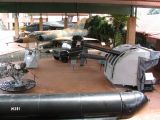 Apart
from information we also found a lot of military hardware. I was surprised
to find lots of planes including old planes like German Messerschmitt,
British Spitfire and even one of the first jet planes that the Germans
developed during World War 2. Outside there were more modern jet planes on
display. There were also an impressive collection of tanks, canons, small
arms, decorations, uniforms etc. I enjoyed the visit to the museum and for
that price it was a bargain. It is a bit sad to admit it but it is quite
interesting to see how much effort man has put into building stuff to be
able to kill each other. If you are into history and military hardware I
would recommend a visit to this museum.
Apart
from information we also found a lot of military hardware. I was surprised
to find lots of planes including old planes like German Messerschmitt,
British Spitfire and even one of the first jet planes that the Germans
developed during World War 2. Outside there were more modern jet planes on
display. There were also an impressive collection of tanks, canons, small
arms, decorations, uniforms etc. I enjoyed the visit to the museum and for
that price it was a bargain. It is a bit sad to admit it but it is quite
interesting to see how much effort man has put into building stuff to be
able to kill each other. If you are into history and military hardware I
would recommend a visit to this museum.
Language
Did you know that South Africa has 11 official languages? The languages (in
alphabetical order) are Afrikaans, English, Ndebele, Pedi, Sotho, Swazi,
Tsonga, Tswana, Venda, Xhosa, and Zulu. You can get by without any problems
speaking English in Joburg.
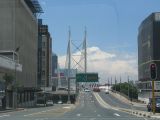 When
I came there the first time I was a bit surprised by a few words. Nikki kept
on saying “turn right at the robots” when she was giving me driving
instructions. Well, I didn’t really see that many robots in the streets :-)
But robots is the word for traffic lights. When I talked to Nikki’s family
and telling them things they kept on saying “izzit?” (like in “is it?”).
Well, my natural response was of course to confirm by saying “Yes” but later
on I realized that the “izzit” is just a phrase being used when you listen
to someone tell a story and I guess it can be translated into “really?”
There is also the expression “howzit” which is more or less like “Hi, how
are you?”
When
I came there the first time I was a bit surprised by a few words. Nikki kept
on saying “turn right at the robots” when she was giving me driving
instructions. Well, I didn’t really see that many robots in the streets :-)
But robots is the word for traffic lights. When I talked to Nikki’s family
and telling them things they kept on saying “izzit?” (like in “is it?”).
Well, my natural response was of course to confirm by saying “Yes” but later
on I realized that the “izzit” is just a phrase being used when you listen
to someone tell a story and I guess it can be translated into “really?”
There is also the expression “howzit” which is more or less like “Hi, how
are you?”
I also kept on asking for ketchup and got pretty blank faces. In this part of the world we’re only talking about “tomato sauce”. Talking about food: one of the South African past times is barbecuing - known as ‘braai’. One of the best things to braai is a boerewors - an excellent meat sausage (mixed with herbs & spices). There are many websites that are dealing with this issue and here is a link to one of them.
Safety
 Most people that I have spoken to associate Johannesburg with one thing:
crime. Unfortunately the city has got a bad reputation and I was a bit
scared too when I got there the first time and Nikki told me about the
safety precautions that she usually took when she was driving, staying at
home etc. These are issues that I never really give any thought to in
Norway. According to BBC (in September 2004) murders committed in the year
to April fell by 8% to just under 20,000 compared with the previous 12
months. Canada which has a similar sized population has only about 550
murders on average per year. I guess it is not fair comparing these two
countries but I guess it shows that South Africa has a challenge when it
comes to crime.
Most people that I have spoken to associate Johannesburg with one thing:
crime. Unfortunately the city has got a bad reputation and I was a bit
scared too when I got there the first time and Nikki told me about the
safety precautions that she usually took when she was driving, staying at
home etc. These are issues that I never really give any thought to in
Norway. According to BBC (in September 2004) murders committed in the year
to April fell by 8% to just under 20,000 compared with the previous 12
months. Canada which has a similar sized population has only about 550
murders on average per year. I guess it is not fair comparing these two
countries but I guess it shows that South Africa has a challenge when it
comes to crime.
Getting
around in Joburg
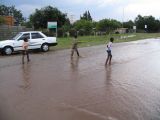 So
how do you get around in Joburg? To make a long story pretty short I think
that it is safe to say that it is hard to explore Joburg if you don’t have a
car. Yes, there are buses and taxis but I’m not sure if they will get you to
your destinations in an efficient way. Even if you do have a car it can be
tricky to get around. First of all you have to deal with the fact that they
drive on the wrong side on the road (ok, the drive on the left side if that
makes it clearer :-) and they have a different driving style. The speed
limit on the highway is 120 km/h and they drive really close to each other
especially when they are trying to indicate that they want to over take you.
It seems like there is a bit of focus on road safeties these days with
posters along the roads with Speed Kills,
Arrive alive,
radio adverts telling you to buckle up etc. But I do recall that the French
and Italians are also notoriously bad drivers – so ‘bad’ driving styles are
comparable. The tow trucks are nick named ‘vultures’ …small tow trucks wait
at different intersections and I guess they are only waiting around for an
accident to happen. Rumour has it that they get to the site of the accident
before the police and paramedics.
So
how do you get around in Joburg? To make a long story pretty short I think
that it is safe to say that it is hard to explore Joburg if you don’t have a
car. Yes, there are buses and taxis but I’m not sure if they will get you to
your destinations in an efficient way. Even if you do have a car it can be
tricky to get around. First of all you have to deal with the fact that they
drive on the wrong side on the road (ok, the drive on the left side if that
makes it clearer :-) and they have a different driving style. The speed
limit on the highway is 120 km/h and they drive really close to each other
especially when they are trying to indicate that they want to over take you.
It seems like there is a bit of focus on road safeties these days with
posters along the roads with Speed Kills,
Arrive alive,
radio adverts telling you to buckle up etc. But I do recall that the French
and Italians are also notoriously bad drivers – so ‘bad’ driving styles are
comparable. The tow trucks are nick named ‘vultures’ …small tow trucks wait
at different intersections and I guess they are only waiting around for an
accident to happen. Rumour has it that they get to the site of the accident
before the police and paramedics.
If you do drive around Joburg have a map reader that can help you out with all the signs along the route. Be aware that there will be some street vendors and beggars on some intersections around town and some intersections are even marked with signs saying “Hijack Hotspot” (a new feature that even locals are not quite used to). Some roads are not that well lit so keep an eye out for people walking along the road. I think that a lot of lives could have been saved if people starting wearing reflector chips like we do here in Norway :-)
Eating out
 Eating out in Joburg is great. There is a great selection of restaurants
with excellent quality and it is so cheap - at least compared to Norwegian
pricing. You can even buy a bottle of good South African red wine without
being ruined :-) We went to a couple of places that I would like to mention.
Moyo is a “chain” of
restaurants around Joburg and we went to the one in Market Theatre in
Newtown. The place was really nice, had a great atmosphere, good food and
you even have the company of a storyteller if you want to. I enjoyed my
Oxtail Potjie there :-) The other place
I would like to mention is
The Butcher Shop & Grill at Nelson Mandela Square
in Sandton.
Eating out in Joburg is great. There is a great selection of restaurants
with excellent quality and it is so cheap - at least compared to Norwegian
pricing. You can even buy a bottle of good South African red wine without
being ruined :-) We went to a couple of places that I would like to mention.
Moyo is a “chain” of
restaurants around Joburg and we went to the one in Market Theatre in
Newtown. The place was really nice, had a great atmosphere, good food and
you even have the company of a storyteller if you want to. I enjoyed my
Oxtail Potjie there :-) The other place
I would like to mention is
The Butcher Shop & Grill at Nelson Mandela Square
in Sandton.
 We went there one night to get some good meat and we got it :-)
I had crocodile carpaccio as a starter and Nikki and I shared game platter
which included wild boar, ostrich, eland and springbuck. I guess we went all
the way because for dessert we had tiramisu and brownies. There are lots of
restaurants in the square and in the shopping mall itself so it is not a
problem finding something good to eat. If you are
having trouble deciding where to go to eat, check out the web site
www.dining-out.co.za. Here you
will find links to lots of restaurants, maps, menus, price etc. For fast
food I can recommend Nando’s. They serve excellent Peri-Peri chicken and
lots of other chicken dishes :-)
We went there one night to get some good meat and we got it :-)
I had crocodile carpaccio as a starter and Nikki and I shared game platter
which included wild boar, ostrich, eland and springbuck. I guess we went all
the way because for dessert we had tiramisu and brownies. There are lots of
restaurants in the square and in the shopping mall itself so it is not a
problem finding something good to eat. If you are
having trouble deciding where to go to eat, check out the web site
www.dining-out.co.za. Here you
will find links to lots of restaurants, maps, menus, price etc. For fast
food I can recommend Nando’s. They serve excellent Peri-Peri chicken and
lots of other chicken dishes :-)
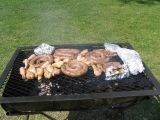 Talking
about food…the South Africans love to braai. We brought along some food and
some cold drinks and went to a park called Zoo Lake after we had been to the
Military museum. In the park we paid a few bucks (Rands) to borrow a braai
stand (half an oil barrel on a stand with a grill rack over it) and we fired
it up and put chicken, chops and boerewors on it. This is a great place to
take the family to relax, braai and enjoy a cold beer. Most people bring a
football or frisbee to kill time – we had to deal with a 10 year old on a
quad bike. After some bickering the family finally understood that quad bike
riding was not allowed in the park. The area seems well kept although
swimming is not allowed and the toilets are, after all, public toilets.
Talking
about food…the South Africans love to braai. We brought along some food and
some cold drinks and went to a park called Zoo Lake after we had been to the
Military museum. In the park we paid a few bucks (Rands) to borrow a braai
stand (half an oil barrel on a stand with a grill rack over it) and we fired
it up and put chicken, chops and boerewors on it. This is a great place to
take the family to relax, braai and enjoy a cold beer. Most people bring a
football or frisbee to kill time – we had to deal with a 10 year old on a
quad bike. After some bickering the family finally understood that quad bike
riding was not allowed in the park. The area seems well kept although
swimming is not allowed and the toilets are, after all, public toilets.
Shopping
 We did go shopping a little bit in Joburg and the price level on some items
is pretty good compared to Norway at least. There are some larger malls
worth mentioning.
Sandton City in the north of Joburg has a lot of stuff to offer.
Here you can go shopping, go to the movies, go out to eat etc. We also went
to Menlyn Park
which is located in Pretoria. This is also a big shopping mall and it houses
shops, an IMAX theatre, Harley Davidson Pretoria etc. We also went to
Fourways Mall to
play adventure golf. If you have been reading the other trip reports you
will notice that we enjoy putt-putt. There is a great 27 hole course here
and when we played there it was at night and it was raining a bit. We could
hear and sea frogs jumping around and when the ball went out of bounds (no,
I never hit my ball out of bounds of course) we were a bit nervous to try to
locate them because you never know what size frogs you will find :-)
We did go shopping a little bit in Joburg and the price level on some items
is pretty good compared to Norway at least. There are some larger malls
worth mentioning.
Sandton City in the north of Joburg has a lot of stuff to offer.
Here you can go shopping, go to the movies, go out to eat etc. We also went
to Menlyn Park
which is located in Pretoria. This is also a big shopping mall and it houses
shops, an IMAX theatre, Harley Davidson Pretoria etc. We also went to
Fourways Mall to
play adventure golf. If you have been reading the other trip reports you
will notice that we enjoy putt-putt. There is a great 27 hole course here
and when we played there it was at night and it was raining a bit. We could
hear and sea frogs jumping around and when the ball went out of bounds (no,
I never hit my ball out of bounds of course) we were a bit nervous to try to
locate them because you never know what size frogs you will find :-)
There is a 14% VAT on stuff that you buy in South Africa and you can get this refunded if the amount exceeds ZAR 250. But to get the money back you have to keep the receipt and you have to present the goods that you have bought at the airport when leaving. You can also get this done at Sandton City to avoid queues at the airport.
Flight home
 It is never fun to end a vacation and it is never fun to say goodbye to the
family. But on Thursday December 30th we packed up our stuff and got ready
to go back to Norway. For the first time we experienced that all our luggage
was weighed at the airport…including hand luggage. Our one piece was 11 kg
over weight and we were told to lighten it or pay. And when we got told that
we had to pay 3500 kroner we decided to leave some of the South African wine
we had decided to bring home. I think this arrangement was strange because
after weighing stuff at the check in, people went to the duty free shops to
buy e.g. wine. The 8680 km flight from Joburg to Frankfurt did go a bit
faster…or maybe it just felt like it since I had a TV to watch and Tetris to
play :-)
It is never fun to end a vacation and it is never fun to say goodbye to the
family. But on Thursday December 30th we packed up our stuff and got ready
to go back to Norway. For the first time we experienced that all our luggage
was weighed at the airport…including hand luggage. Our one piece was 11 kg
over weight and we were told to lighten it or pay. And when we got told that
we had to pay 3500 kroner we decided to leave some of the South African wine
we had decided to bring home. I think this arrangement was strange because
after weighing stuff at the check in, people went to the duty free shops to
buy e.g. wine. The 8680 km flight from Joburg to Frankfurt did go a bit
faster…or maybe it just felt like it since I had a TV to watch and Tetris to
play :-)
Conclusion
We had a great stay in Joburg and I would like to send a big thank you to
Nikki’s family and friends for being such good hosts, for taking us around
in Joburg and for feeding us with all sorts of good stuff. I feel that we
got to see and do quite a lot and I got to celebrate Christmas in a foreign
country for the first time in my life :-) Thanks. I feel that I
did Joburg with an open mind this time and I hope that this trip report has
shown that there are a few things to see and do in this city. I agree that
it might not be your standard tourist destination but I hope that people now
at least can associate with something else apart from crime. My
recommendation is to rent a car while in Joburg so that you can get a chance
to take a look at the city. Get a good map so that you can find your way
around town. And don’t worry…as long as you take normal precautions you can
explore this city like any other big city around the world :-)
Please continue to page 2 and read more about our safari Djuma Game Reserve located in the Sabi Sand Game Reserve near the Kruger Park.